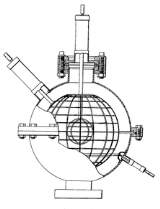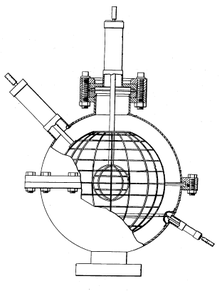
Inertial electrostatic confinement
Encyclopedia
Inertial electrostatic confinement (often abbreviated as IEC) is a concept for retaining a plasma
using an electrostatic field. The field accelerates charged particles (either ions or electrons) radially inward, usually in a spherical but sometimes in a cylindrical geometry. Ions can be confined with IEC in order to achieve controlled nuclear fusion
. One of the earliest proposals for IEC was by Willam C Elmore, et al in January 1959.
 The best-known IEC device is the Farnsworth-Hirsch Fusor. This system consists largely of two concentric spherical electrical grids inside a vacuum chamber into which a small amount of fusion fuel is introduced. Voltage across the grids causes the fuel to ionize around them, and positively charged ions are accelerated towards the center of the chamber. Those ions may collide and fuse with ions coming from the other direction, may scatter without fusing, or may pass directly through. In the latter two cases, the ions will tend to be stopped by the electric field and re-accelerated toward the center. Fusors can also use ion gun
The best-known IEC device is the Farnsworth-Hirsch Fusor. This system consists largely of two concentric spherical electrical grids inside a vacuum chamber into which a small amount of fusion fuel is introduced. Voltage across the grids causes the fuel to ionize around them, and positively charged ions are accelerated towards the center of the chamber. Those ions may collide and fuse with ions coming from the other direction, may scatter without fusing, or may pass directly through. In the latter two cases, the ions will tend to be stopped by the electric field and re-accelerated toward the center. Fusors can also use ion gun
s rather than electric grids.
The fusor is popular because simple versions can be built by many people, making it accessible to those that want to explore this field. Even these simple devices can reproducibly and convincingly produce fusion reactions, but no fusor has ever come close to producing a significant amount of fusion power
. They can be dangerous if proper care is not taken because they require high voltages and can produce harmful radiation (neutrons, gamma rays and x-rays). The basic IEC device has been developed as a commercial neutron generator
for industrial applications: first with the trade name FusionStar and now NSD-Fusion.
Three newer approaches try to solve a problem found in the fusor, which is that some ions collide with the grids. This heats the grids, sprays high-mass ions into the reaction chamber, pollutes the plasma, and cools the fuel. The Polywell
uses a magnetic field to trap a quantity of electrons, fuel ions are then accelerated directly into the middle where they are trapped by the electron cloud that forms a "virtual electrode".Another modern approach uses a Penning trap
to trap electrons in a system otherwise similar to the Polywell. A third approach, dubbed MARBLE, uses electrostatic optics to keep ions on orbits that do not intersect grid wires - the latter also improves the space charge limitations by multiple nesting of ion beams at several energies.
In 2001, a Japanese team was able to directly measure the double well of an IEC machine using laser-induced fluorescence.
Nevins makes an argument similar to Rider's in [W.M. Nevins, Phys. Plasmas <2> (10), 3804 (October, 1995)], where he shows that the fusion gain (ratio of fusion power produced to the power required to maintain the non-equilibrium ion distribution function) is limited to 0.1 assuming that the device is fueled with a mixture of deuterium and tritium. A fusion gain of about 10 is required for net energy production. Other fusion researchers such as Rostoker and Monkhorst have disagreed with these analyses, claiming their assumptions do not always apply, and proposing nonthermal schemes that they calculate can produce net power, and theorists at LANL
have proposed a new electrostatic plasma equilibrium that should mitigate this problem. This concept, called Periodically Oscillating Plasma Sphere (POPS), has been confirmed experimentally. POPS oscillation maintains equilibrium distribution of the ions at all times, which would eliminate any power loss due to Coulomb collisions, resulting in a net energy gain
for fusion-power generation. Furthermore, this is probably the only fusion reactor concept that becomes increasingly efficient as the size of the device shrinks. However, very high transparencies (>99.999%) are required for successful operation of the POPS concept. To this end S. Krupakar Murali et al., suggested that carbon nanotubes can be used to construct the cathode grids. This is also the first (suggested) application of Carbon nanotubes directly in any fusion reactor.
Plasma (physics)
In physics and chemistry, plasma is a state of matter similar to gas in which a certain portion of the particles are ionized. Heating a gas may ionize its molecules or atoms , thus turning it into a plasma, which contains charged particles: positive ions and negative electrons or ions...
using an electrostatic field. The field accelerates charged particles (either ions or electrons) radially inward, usually in a spherical but sometimes in a cylindrical geometry. Ions can be confined with IEC in order to achieve controlled nuclear fusion
Nuclear fusion
Nuclear fusion is the process by which two or more atomic nuclei join together, or "fuse", to form a single heavier nucleus. This is usually accompanied by the release or absorption of large quantities of energy...
. One of the earliest proposals for IEC was by Willam C Elmore, et al in January 1959.
Approaches to IEC

Particle accelerator
A particle accelerator is a device that uses electromagnetic fields to propel charged particles to high speeds and to contain them in well-defined beams. An ordinary CRT television set is a simple form of accelerator. There are two basic types: electrostatic and oscillating field accelerators.In...
s rather than electric grids.
The fusor is popular because simple versions can be built by many people, making it accessible to those that want to explore this field. Even these simple devices can reproducibly and convincingly produce fusion reactions, but no fusor has ever come close to producing a significant amount of fusion power
Fusion power
Fusion power is the power generated by nuclear fusion processes. In fusion reactions two light atomic nuclei fuse together to form a heavier nucleus . In doing so they release a comparatively large amount of energy arising from the binding energy due to the strong nuclear force which is manifested...
. They can be dangerous if proper care is not taken because they require high voltages and can produce harmful radiation (neutrons, gamma rays and x-rays). The basic IEC device has been developed as a commercial neutron generator
Neutron generator
Neutron generators are neutron source devices which contain compact linear accelerators and that produce neutrons by fusing isotopes of hydrogen together. The fusion reactions take place in these devices by accelerating either deuterium, tritium, or a mixture of these two isotopes into a metal...
for industrial applications: first with the trade name FusionStar and now NSD-Fusion.
Three newer approaches try to solve a problem found in the fusor, which is that some ions collide with the grids. This heats the grids, sprays high-mass ions into the reaction chamber, pollutes the plasma, and cools the fuel. The Polywell
Polywell
A polywell device is a type of fusion reactor that was originated by Robert Bussard under a U.S. Navy research contract. It traps electrons in a magnetic confinement inside its hollow center. The negatively charged electrons then accelerate positively charged ions for the purpose of achieving...
uses a magnetic field to trap a quantity of electrons, fuel ions are then accelerated directly into the middle where they are trapped by the electron cloud that forms a "virtual electrode".Another modern approach uses a Penning trap
Penning trap
Penning traps are devices for the storage of charged particles using a homogeneous static magnetic field and a spatially inhomogeneous static electric field. This kind of trap is particularly well suited to precision measurements of properties of ions and stable subatomic particles which have...
to trap electrons in a system otherwise similar to the Polywell. A third approach, dubbed MARBLE, uses electrostatic optics to keep ions on orbits that do not intersect grid wires - the latter also improves the space charge limitations by multiple nesting of ion beams at several energies.
In 2001, a Japanese team was able to directly measure the double well of an IEC machine using laser-induced fluorescence.
Critique
According to Todd Rider in A general critique of inertial-electrostatic confinement fusion systems, net energy production is not viable in IEC fusion for fuels other than D-T (deuterium-tritium fusion), D-D (deuterium fusion), and D-He3 (deuterium-helium 3 fusion), and breakeven operation with any fuel except D-T is unlikely. The primary problem that he discusses is the thermalization of ions, allowing them to escape over the top of the electrostatic well more rapidly than they fuse. He considers his paper optimistic because he assumes that core degradation can be countered.Nevins makes an argument similar to Rider's in [W.M. Nevins, Phys. Plasmas <2> (10), 3804 (October, 1995)], where he shows that the fusion gain (ratio of fusion power produced to the power required to maintain the non-equilibrium ion distribution function) is limited to 0.1 assuming that the device is fueled with a mixture of deuterium and tritium. A fusion gain of about 10 is required for net energy production. Other fusion researchers such as Rostoker and Monkhorst have disagreed with these analyses, claiming their assumptions do not always apply, and proposing nonthermal schemes that they calculate can produce net power, and theorists at LANL
Los Alamos National Laboratory
Los Alamos National Laboratory is a United States Department of Energy national laboratory, managed and operated by Los Alamos National Security , located in Los Alamos, New Mexico...
have proposed a new electrostatic plasma equilibrium that should mitigate this problem. This concept, called Periodically Oscillating Plasma Sphere (POPS), has been confirmed experimentally. POPS oscillation maintains equilibrium distribution of the ions at all times, which would eliminate any power loss due to Coulomb collisions, resulting in a net energy gain
Net energy gain
Net Energy Gain is a concept used in energy economics that refers to the difference between the energy expended to harvest an energy source and the amount of energy gained from that harvest. The net energy gain, which can be expressed in joules, differs from the net financial gain that may result...
for fusion-power generation. Furthermore, this is probably the only fusion reactor concept that becomes increasingly efficient as the size of the device shrinks. However, very high transparencies (>99.999%) are required for successful operation of the POPS concept. To this end S. Krupakar Murali et al., suggested that carbon nanotubes can be used to construct the cathode grids. This is also the first (suggested) application of Carbon nanotubes directly in any fusion reactor.
External links
- University of Wisconsin-Madison IEC homepage
- From Proceedings of the 1999 Fusion Summer Study (Snowmass, Colorado):
- Inertial-Electrostatic Confinement (IEC) of a Fusion Plasma with Grids
- Fusion from Television? (American Scientist Magazine, July-August 1999)
- Todd Rider's 1994 Masters Thesis
- Talk by Dr. Robert BussardRobert W. BussardRobert W. Bussard was an American physicist who worked primarily in nuclear fusion energy research. He was the recipient of the Schreiber-Spence Achievement Award for STAIF-2004. He was also a fellow of the International Academy of Astronautics and held a Ph.D...
, former Asst. Director of the Atomic Energy Commission and founder of Energy Matter Conversion Corporation (EMC2):- Should Google Go Nuclear? Clean, cheap, nuclear power (no, really) Google Tech Talk November 9, 2006.
- 'The Advent of Clean Nuclear Fusion: Superperformance Space Power and Propulsion' cited in the Dr. Bussard's Talk. 57th International Astronautical Congress 2006 Author: Dr. Robert W. Bussard
- Latest Fusion developments (WB-7 - June 2008) based on the work of Dr. Robert Bussard
- Website of FPGeneration, Inc

